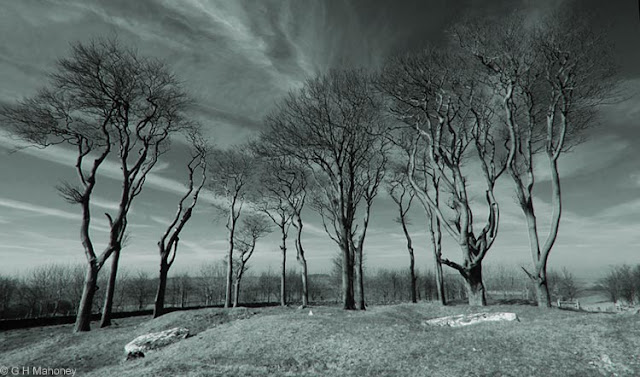 |
| Mystic Minninglow |
(Canon EOS 60D, Sigma 17-70mm @ 17mm, HDR tonemapped and post-processed in Photoshop)
On a lovely sunny morning I took a 5.5 mile walk past Minninglow, Roystone Grange and Ballidon Quarry. Minninglow has fascinated me since I was a boy growing up in Derbyshire. A distinctive group of Beech trees stands at the top of a small hill. Hidden within is a Neolithic chambered cairn. I was never able to visit as there was no public access but there is now a concessionary footpath. The tall, old Beech trees tower over the remains of the cairn, surrounded by a stone wall and a younger plantation.
This is the story of my walk.
The walk starts from the Minninglow car park and picnic site on the High Peak Trail. The trail is along the track of a dismantled railway, the High Peak and Cromford. The line was opened in 1831 and connected the Cromford Canal with the Peak Forest Canal at Whaley Bridge. It was considered an engineering marvel at the time with high stone built embankments and steep gradients. The line was finally closed to traffic by the Beeching Axe in 1967. The photo above was taken from one of the embankments.
In the distant mist Minninglow appears as I follow the High Peak Trail.
Looking back, one can see one of the stone embankments built to carry the railway. The railway reached a height of over 1000', the highest built at the time, and gradients were as steep as 1 in 8! The first steam engine to use the line was
Peak built by Robert Stephenson and Co.
The line passed over high grade Limestone and several quarries were built close by. This one is near Minninglow.
Some of the old machinery is still there such as this stone crushing machine. In places, you can still make out the rails of the quarry sidings.
Looking back from the climb up to Minninglow one can see two of the great stone embankments.
A black and white photo captures the mood at Minninglow. Stones from the chambered cairns can be seen in the foreground. The cairns have been excavated and looted since Roman times (Roman pottery and coins being found in one). Most recently in the 1960s when considerable damage was done.
The capstone of one of the chambers. Probably weighing several tons, at least it didn't need to be transported far as it is of the local Limestone.
After heading back down from Minninglow the footpath passes through a short tunnel under the High Peak Trail.
By now the weather was glorious, 15 deg C., warm enough to really enjoy the views of the Derbyshire countryside.
This farm is Roystone Grange. The Cistercian Abbey of Garendon, Liecestershire established the farm in the 12th century. Little remains of the original buildings and the new farm, in the photo, was built after the dissolution in the 16th century.
This building was erected nearby in the 19th century as a pump house. A steam engine compressed air through cast iron pipes to drive rock drills in the many quarries along the High Peak line.
The lane leading south from Roystone Grange runs in the bottom of a dale, unnamed on the OS map, towards Ballidon.
Ballidon Quarry is still worked. It produces large amounts of very high quality Limestone. The Limestone was formed in calm tropical seas in the Carboniferous era and consist almost entirely of the calcified remains of sea creatures with very few impurities.
The distinctive profile of Minninglow was clearly visible on the last section of the walk, along the road from Parwich to the Car Park. An excellent walk!




























